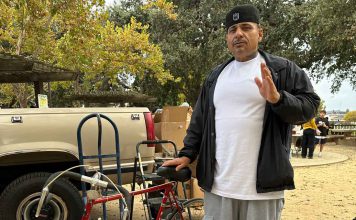Amazingly, the new pope has a connection to our own South Valley region.
Well … kind of.
Tuesday when Germany’s Joseph Ratzinger took on his new name of Pope Benedict XVI, he accidentally created the link. As the white smoke drifted over Vatican City, former Cardinal Ratzinger re-christened himself after the famous St. Benedict. It just so happens San Benito County is also named after St. Benedict.
Wow! What an amazing coincidence, you’re thinking. Okay, I’ll admit the connection is a bit of a stretch. But please understand the pope’s election was this week’s biggest news event. And, well … I needed to figure out some way to link the papal leader of 1.1 billion Roman Catholics with our own California corner. Given the short notice, this was the best I could do.
Now you’re probably asking: who exactly is St. Benedict, and why was a South Valley county named after him? So, free of charge for readers of this newspaper, I did some in-depth journalistic investigation on the dude. Going on line, I googled the search words ST. BENEDICT HISTORY. And this is what I learned from his order’s official Web site.
Around the year 480, Benedict was born in Nursia, an Umbrian town near Spoleto, Italy. In the 500s, he founded a new Christian movement focused on the principles of “monasticism.”
For about two centuries before Benedict, Christian men and women went into the wilderness to get far away from civilization and closer to God. Becoming “one with God” was their goal. So they were known as “monks” – a word derived from the Latin root “mon” for “one.” (Later, the word “nuns” denoted women.)
Unfortunately, just like modern TV evangelists, Christianity’s early days weren’t immune from shucksters pulling financial fast ones on innocent folks. Some unscrupulous monks were nothing more than con artists swindling a buck wherever they could find a sucker.
Benedict, by the early 500s, had founded an Italian monastery called Monte Cassino where he served as abbot. He realized all Christian monks were getting a bad rap because people associated them with the schemer monks. So he came up with a revolutionary idea: set up monastic rules of conduct for monks and lay people to live by.
His rules guided people to emulate Christ in their daily lives. Over time, his rules helped people trust monks again.
Of course, becoming a saint requires performing some sort of miracle. They don’t pass out the title to just anyone, you know. And Benedict’s miracle was one that certainly might please domestic diva Martha Stewart.
One day, Benedict’s nurse borrowed an earthenware sieve to do some cooking. Unfortunately, it fell off the table and broke in two. The poor lady was devastated by the disaster. Benedict tried to console her. Not having any Krazy Glue conveniently at hand, he decided to try prayer. He bowed his head and asked God to mend the sieve. The next moment they saw the perfectly-repaired kitchen utensil before them.
Okay, as miracles go, it ain’t exactly parting the Red Sea. But it did the trick. Benedict’s now “the patron saint of servants who break things.” Honest.
St. Benedict died on March 21, 547, and was buried in a Monte Cassino tomb. His Benedictine order still continues today.
Now our story jumps to 1770s California when the Spanish started scouting out their chunk of coastal real estate to colonize it. To protect Spanish land from threatening nations, Don Gaspar de Portola helped found the Monterey presidio.
In 1772, Portola selected Capt. Pedro Fages to lead 12 soldiers in an inland expedition tour. Franciscan Father Juan Crespi tagged along to keep a travel journal and draw terrain maps.
On March 20, 1771, the 14 men left Monterey. After crossing the Gabilan Mountains, the next day they discovered a beautiful valley with a river meandering through its heart. March 21 is St. Benedict’s Day. So Crespi thought it fitting to name the newly-discovered waterway in honor of the Italian saint. Rio San Benedicto they called it – rolling the “R” with a trill sound I personally never mastered in high school Spanish class. (Later generations shrank the name to “San Benito.”)
The explorers continued northward to the eastern shores of San Francisco Bay, passing through territory that’s now Gilroy, San Martin and Morgan Hill. But for purposes of this history, we’re finished with their saga.
In the next hundred years, more Europeans moved to California. The Gold Rush particularly drew many Americans here. These immigrants found the paradise-perfect climate and fertile plains of South Valley so inviting, they settled here as farmers and ranchers. Small agricultural towns soon developed.
After becoming the end of a railroad branch line, the hamlet of Hollister experienced a population boom in the early 1870s. Unfortunately, a logistical problem developed.
Hollister was part of Monterey County, and Salinas was the county seat. Back then, citizens east of the Gabilans were forced to make an arduous two-day round trip by horse or buggy to take care of county government and legal business. For convenience sake, Hollister folks petitioned to divide Monterey County in two and making their town the county seat.
But what to name the just created county? The main waterway was the mighty San Benito River (which becomes a dry creek in summer). So in 1874, someone thought it suitable to name their new county after the local river. San Benito County was born.
In recent years, after Hollister’s Sacred Heart Church grew too small, a new chapel was built on the eastern city limits. It’s called St. Benedict’s Catholic Church to honor the holy man the county was named after.
There you have the history of the name chain from St. Benedict to San Benito County. And this week the brand-new pope chose to name himself after the virtuous St. Benedict.
So if you live in San Benito County, you now share something in common with the pope. Just don’t go around wearing any pointy papal hats now.












